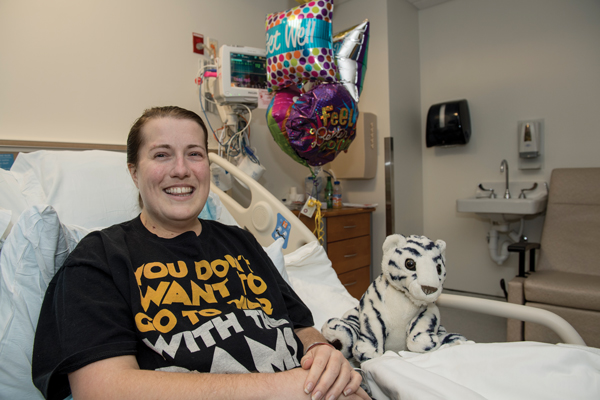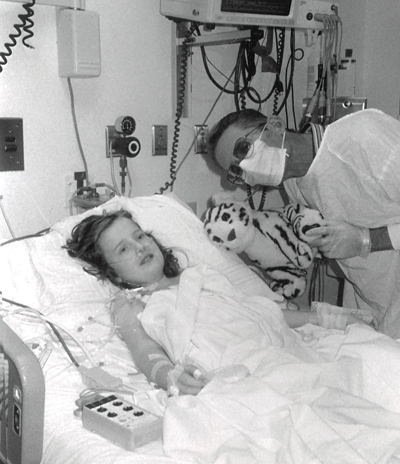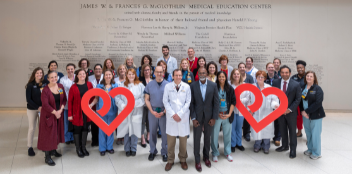Proud of Its Past. Poised for the Future.
By Janet Showalter
Jeni Simonitis was 8-years-old as she lay in a hospital bed at MCV Hospitals, now VCU Medical Center, in December 1992.

With her parents by her side, she anxiously awaited news that a donor heart had been found to save her life.
Twice she went into cardiac arrest.
“It was scary,” she said. “We weren’t sure they would find a match in time. But they did. I remember the doctor coming in and telling us we had a heart. It was a Christmas miracle.”
Twenty-five years later, in December 2017, Simonitis underwent her second successful heart transplant at VCU Medical Center.
“It never crossed my mind to go anywhere else,” said Simonitis, 34. “The team there is just amazing. They are passionate about what they do, and they are the best in the field.”
The world’s first successful human-to-human heart transplant took place in December 1967 in South Africa. Five months later, the first heart transplant in Virginia — ninth in the country and 16th in the world — took place at MCV Hospitals.
Since that historic moment 50 years ago, the team has completed more than 590 heart transplants, including the first heart-lung transplant in Virginia and the first total artificial heart transplant on the East Coast. It is the second-oldest heart transplantation program in the U.S.
“It’s an amazing thing we do here,” said Dr. Daniel Tang, the Richard R. Lower, M.D. Professorship in Cardiovascular Surgery and director of heart transplantation, heart-lung transplantation and mechanical circulatory support. “It may not be uncommon anymore, but it is hardly routine. The very notion that we are taking a heart that was someone else’s and giving it to a patient so that they may have life is truly amazing. It is very emotional and never gets old.”
Since that historic moment 50 years ago, the team has completed more than 590 heart transplants, including the first heart-lung transplant in Virginia and the first total artificial heart transplant on the East Coast. It is the second-oldest heart transplantation program in the U.S.
The race to perform the first human-to-human heart transplant was a competitive one.
“It was similar to the race to get a man on the moon,” said Dr. Keyur Shah, section chief of heart failure. “Anytime you accomplished anything to get you closer to your goal, you were on the cover of Time magazine.”
The breakthrough was one of the most significant in the field of medicine in the 20th century, with the late MCV surgeon Dr. Richard Lower leading the way. Lower, along with Dr. Norman Shumway, began extensive research in California in the late 1950s and later successfully completed the first heart transplant in an animal model.
Their work grabbed media attention, as well as the eye of renowned transplant surgeon Dr. David Hume, chief of surgery at MCV Hospitals at that time. In 1965, Lower accepted Hume’s invitation to join him in Richmond to lead the cardiac surgery program.
As the team inched closer to its ultimate goal, Dr. Christiaan Barnard, a young South African surgeon, visited Richmond for three months to observe the team’s work. He became obsessed with becoming the first surgeon to perform
a human heart transplant.
A few weeks after Barnard returned to South Africa, Lower and Hume nearly performed the first transplant but decided against it because the donor and recipient blood types did not match.

That opened the door for Barnard, who found a donor for a patient under his care. On Dec. 3, 1967, Barnard successfully performed the world’s first human-to-human heart transplant. Lower performed his first in May 1968. In all, he took part in 393 heart transplants before he retired in 1989.
“Lower was cautious, as he should have been,” said Dr. Michael Hess, who worked with Lower for 10 years and started the heart failure program. “He did groundbreaking work that led to incredible growth in the field.”
Soon after Hess became medical director of cardiac transplantation in 1979, the team was well on its way to performing more than 50 heart transplants a year.
“We were demystifying cardiac transplantation,” said Hess, who retired in 2017. “People back then thought we were crazy as hell. Or they thought it was a piece of cake. Today, it is standard heart patient care.”
But when Lower retired, the program took a hit. Several other surgeons and physicians also left, and three other transplant programs opened in Virginia. The number of heart transplants completed at MCV Hospitals plummeted to fewer than 10 annually.
“When I interviewed for a job here in 1999, they had done only one transplant that year,” said Dr. Vigneshwar Kasirajan, the Stuart McGuire Chair of Surgery. “But we were able to rebuild it. I am most proud of the team we have assembled here.”
Over the past 15 years, the number of heart failure and transplantation cardiologists at VCU Medical Center has grown from two to six while the number of surgeons has doubled to four.
Today, the medical center averages 25 transplants a year, including several multi-organ transplants.
“This has been a second coming,” Shah said. “Our staff takes a lot of pride in that, and our patients can see the passion we have in serving our community.”
Each year, thousands of patients turn to the center for inpatient and outpatient care, ranging from noninvasive cardiology procedures to heart transplantation. Pauley’s transplant and heart failure experts speak at national conferences, lead clinical trials, take part in funded research and have published hundreds of abstracts and manuscripts.
The center has become known worldwide for its groundbreaking work, and Pauley leads the way in device-based treatments for advanced heart failure. In 2006, Kasirajan led the team that completed the first total artificial heart implant on the East Coast.
Since then, VCU Medical Center has performed more than 100 artificial heart transplants, and its program is the third largest in the country. Pauley also implants about 40 ventricular assist devices a year. A VAD is a mechanical pump that helps the heart push blood to the body. Artificial hearts and VADs can allow a heart transplant candidate to safely survive until a donor heart becomes available.
“This work has become mainstream,” Kasirajan said. “It’s incredible how far we’ve come.”
For some, it might sound like science fiction. For others, research in the areas of stem cell and gene therapy, genetic coding and xenotransplantation offers a promising future.
“People looked at what Lower was doing 50 years ago and thought those guys were absolute cowboys because they were doing something that was so unusual,” said Tang, who performs about half of the heart transplants at VCU Medical Center. “Their work evolved into what we are doing today. People may think that the days of the cowboy are over. I would argue it is not.”
Stem cell therapy, now in the trial stage, is showing great promise in repairing tissue damaged by heart attacks. If successful, this would save patients who otherwise need a heart transplant.
Another national study underway is for the Carmat heart, which has been called the world’s first self-regulating, total artificial heart. It uses embedded sensors to regulate the rate of blood flow to a patient based on his or her individual needs.
Tang is also excited about research that could lead to an increase in donor hearts. Currently, about 2,500 heart transplants are performed in the U.S. each year. But about 4,000 people nationwide are waiting.
“The need is great,” Tang said. “We need to do all we can to meet it.”
The prime window to successfully use a donor heart is four to six hours after death. That time frame is not always plausible because of distance to the recipient, and sometimes the heart goes unused. But new ways to expand protection times are being studied, including a pump system that would keep the heart viable until it arrives at its destination.
Another area of study by Dr. Mohammed Quader, assistant professor of surgery, is exploring ways to recover a heart from a person who has suffered a cardiac death. Currently, donor hearts are used only if the person suffers brain death because blood continues to flow to the heart. In a cardiac death, blood ceases to flow and the heart sustains cellular damage. But research is uncovering ways to protect the donor heart from cellular damage, making it viable for transplantation.
In addition, the ongoing study of modifying genetic signatures could one day open the door to cross-species heart transplantation.
“It’s very exciting to think what the future can bring,” Tang said.
Tang, who performed Jeni Simonitis’ surgery in December, said that while the procedure is becoming more common, he will never get used to the miracle it is.
“When you call the patient and tell them we have found a donor heart for them, they jump for joy,” he said. “Even though they know it is a daunting surgery, they look forward to it.”
Simonitis can remember the fear she felt as a young girl, clutching her stuffed tiger, Stripes, in her hospital bed. Born with a heart defect, a transplant was her only option.
“As they were wheeling me to surgery, I got scared and wanted to back out,” she said. “But I knew I had to do it. A few months later, I was back on the playground with my friends. I got my life back.”
For more than 20 years, her donor heart served her well. The average life expectancy of a donor heart is 12 years, with some lasting three decades. When Simonitis began experiencing chest pains three years ago, she hoped it was heartburn. It turned out to be a form of chronic rejection.
In August 2017, Simonitis was placed back on the transplant list. Four months later, she got the call that a donor heart had been found. She and her husband, Jason, grabbed her bag, already packed with clothes and Stripes, and drove to VCU Medical Center. A few hours later, she was in surgery. This time around, her hospital stay was two weeks instead of three. She missed nine weeks of work.
“It’s amazing how much more advanced they are now,” Simonitis said. “Technology is better, the medications are better and the surgeons, I think, are more skilled. The team is right there with you through it all. I trusted them every step of the way.”
As she did after her first surgery, Simonitis will send a letter to the donor family, offering her gratitude.
“Words can’t possibly express how thankful I am,” she said. “I know my heart came at a cost. It means someone else’s family suffered great tragedy. I never lose sight of that. Every year on the anniversary of my surgery, I celebrate that family. They gave me the greatest gift possible. They gave me life.”
Janet Showalter is a contributing writer for the alumni magazine.
This article was originally published in the spring 2018 VCU Alumni magazine. Alumni can read the whole magazine online at vcualumni.org
NOW ON HER SECOND HEART TRANSPLANT, JENI SIMONITIS STILL HAS THE SAME STUFFED ANIMAL FROM HER FIRST TRANSPLANT AT AGE 8.
VCU Medical Center’s heart transplant program was established in 1968, making it the longest-running transplant program on the East Coast and the second oldest in the U.S.
- MCV Hospitals celebrated the first long-distance heart transplant in the world in 1977 when Dr. Szabolcs Szentpetery made the 600-mile flight from Richmond to Indianapolis to bring back a donor heart.
- In 1981, Dr. Michael Hess created the International Society of Heart and Lung Transplantation.
- The first heart-lung transplant in Virginia took place at MCV Hospitals in 1986.
- In 1994, the first left ventricular assist device was implanted at MCV Hospitals.
- The first total artificial heart on the East Coast, and the third in the country, was implanted at VCU Medical Center in 2006.
- VCU Heart Center was renamed VCU Pauley Heart Center in 2006 to recognize a $5 million gift from the Pauley Family Foundation.
- The center has 14 endowed professorships and chairs.
- Since 1972, the American Heart Association has funded 138 VCU Health researchers with $12.8 million.


